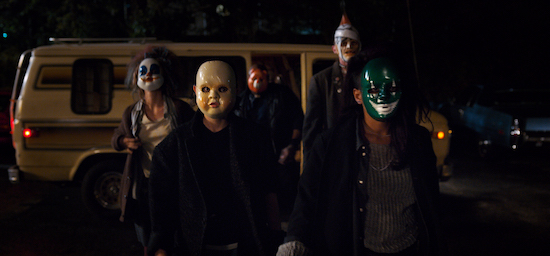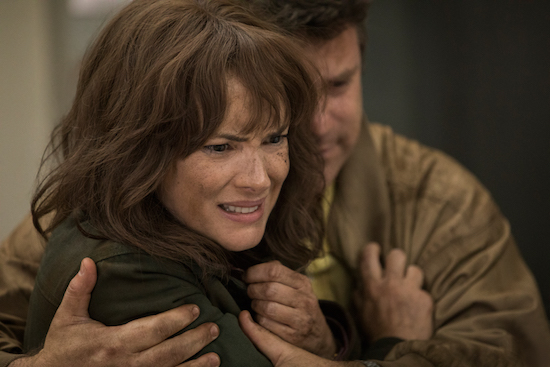I was ten years old in 1982, the year Steven Spielberg’s E.T. The Extra Terrestrial launched, rapidly becoming became the highest grossing film of all time (it’s still the highest grossing of the 80s). I vividly remember the buzz around it, which was, in essence, "this movie makes grown men cry".
Seeing it that year, even as a ten year old, I wrinkled my nose at Spielberg’s over-wrought button pushing, and felt vaguely insulted by the way the movie aggregated dialogue, shot framing and score into what might as well have been title cards popping up saying CRY NOW, IDIOTS. I dunno, maybe I was bad at being a kid. Or maybe it only worked on grown men.
It was a good couple of decades later that I finally warmed to it a little, half-watching it on a weekend afternoon. The central story of the friendship between the kid and the alien still left me cold – or I should say Spielberg’s emotional ham-fistedness still generally does – but the smaller details I hadn’t picked up on as a child struck me very powerfully. A barely-mentioned absentee father casts a looming shadow over the whole story; the obviously once-salubrious, now slightly-falling-apart home; the single mother not quite keeping the strain of the situation hidden from the kids. That, for me, was the powerfully resonant stuff. What the hell did I care if the love child of a giraffe and Peter Lorre got back to his home planet. I wanted to know what happened when the gas bill didn’t get paid.
Stranger Things borrows heavily from E.T., and from 80s genre cinema in general, but showrunners the Duffer Brothers have focussed on precisely that kind of background detail. There is a sci-fi frame, but it’s no more then "Some Bad Science Men Have Done A Bad Science Thing, Which Has Caused Badness". While the metaphysics of the Stranger Things universe appear to be well-worked out and internally consistent, the show spends strikingly little time exploring them; they’re simply not the point.
Set in small town North America in the early 80s, the show is superficially nostalgic; the period detail, from clothes to cars, right down to wallpaper and furniture is all right on the nail. There’s an absence of lazy signifiers, though; no roller-skates, leg-warmers and Rubik’s Cubes here. The point rather is that this is a show about childhood, seen from the children’s point of view, but made for an adult audience.

The 80s back-drop isn’t deployed in a reassuring or cosy way. The cold war is a subtle, ominous background note; the danger of a world without mobile phones, where kids can simply disappear is another. There’s a creeping sense of early 80s economic unease, and a keener eye for the post-70s decline of the western working class than you’ll see in most modern TV drama. None of this is warm and reassuring; if anything, Stranger Things asserts that the 80s, and childhood itself, were bleaker than you now recall.
Stranger Things 2 (not a TV ‘season 2’, note, but a movie blockbuster ‘2’) has quite a job on its hands. The first season was last year’s surprise word-of-mouth hit for Netflix, and they and the Duffers quickly changed course from, "Hmm, maybe a season two, and maybe an anthology show or something" to a definite four to five seasons following the same characters.
As such, the neat narrative arc of the previous season isn’t available. In season one, the distressed mother and friends of a missing boy, who know he’s been abducted by a supernatural entity, struggle against and finally overcome the scepticism of authority figures and other family members. Everyone then joins forces to fight said bogeyman.
Season two, therefore, opens in a world where a sizable number of characters have seen, with their own eyes, telekinetic battles between a superpowered child and a Lovecraftian beast from beyond; have travelled into a dark mirror world; are fully aware of, and signed up to, a governmental cover-up of all that has gone before.
The show has wisely not decided to try to dodge that problem by coming up with a wholly new adventure and adversary for our plucky kids. Indeed, while the story is set a whole year after season one, it cleverly ties the two together, and presents a seamless continuity; a lot has happened in that year off air, but nothing has been resolved or reset. "Nothing’s going to go back to the way it was", as Police Chief Jim Hopper (David Harbour) intones in the show’s final pre-season trailer.
At heart, the show is about ordinary people coping with mostly-ordinary trauma. Parental neglect, bereavement, relationship failure, failure in general. That some of these traumas come at the hands of a pan-dimensional entity is actually neither here nor there. We see that in the wake of season one’s events, certain relationships have fractured, others have strengthened, and coping strategies of varying effectiveness are in place.

Joyce Byers (Winona Ryder) is now a slightly calmer presence, after spending season one continually on the verge of a nervous breakdown (a performance I found a mesmerising high-wire act, but some found a little one-note). Shacked up with the amusingly-named Bob Newby, she’s attempting to make life as normal as possible for her son Will, the still-freaked-out abductee from season one. After mostly playing dead or semi-conscious last year, Noah Schnapp, as Will, gets a lot more screen time this season, and turns in a fantastic performance well up to par with the other child actors.
However, it takes almost no time for the pan-dimensional shit to hit the telekinetic fan, and our core characters are back in action right where we left them. Within minutes of the opening, Will has a horrifying vision of a colossal beast, like one of Louise Bourgeois’s spider sculptures, but of town-bestriding size. Hopper soon spots Bad Science trouble afoot due to some Halloween-signifying weirdness in a pumpkin crop, and it’s secret labs and freaky monsters right from the get-go.
Pleasingly, the show doesn’t make us slog through expository set-up; it assumes you’ve either seen what’s gone before, or are smart enough to pick it up. Indeed, when one returning character has to explain to a new character what’s been going on, we simply cut to something else, and return when they’ve finished talking. Coming just after the horribly scripted Mindhunter, a show that fancies itself more intelligent fare, but in which characters mostly just sit and boringly explain the plot to each other, I found this somewhat refreshing.
Season one attracted much praise for how seamlessly it hopped between genres, from the E.T./ Goonies/ Stand By Me mash-up of the kids’ story, to the Pretty In Pink / Breakfast Club stylings of the teen sequences and the bleaker domestic drama of the Joyce and Hopper sequences. To this palette has been added a much heavier dose of horror, with echoes of The Exorcist, Carrie and David Cronenberg’s slithering, queasy physicality.

There’s also a lot more pure comedy. Millie Bobbie Brown as Eleven, the traumatised super-powered child, is at last given more to do than her (admittedly always-masterful) conveyance of deep anguish, and delivers a lot of deadpan laugh-out-loud moments. Gaten Matarazzo as Dustin is a bigger presence this time, and is growing into a superb comic actor. Caleb McLaughlin as Lucas gets a sweetly awkward first-adolescent-girlfriend story arc, and much more opportunity to shine as a result. Overall, the four main kids feel more of a rounded ensemble cast this time, and the scripts are tightly written to their various strengths.
These huge shifts in tone are once again as elegantly handled as before. During one episode, I had to rewind to check out how much time had elapsed between me feeling like I was watching the last half of Aliens and the dénouement of Sixteen Candles; it had been seven minutes. But these shifts almost never jar. If I have a criticism on this front, the detour into the 80s movie Big Bad City Street Punk trope feels like a bit of a reach, more there for the hell of it than narrative necessity. But it’s such immense fun, it seems churlish to complain.
What glues all this stuff together is the depth of the characters, both in writing and performance. Everyone has an interesting arc, and almost nobody is what they first seem. However absurd the back-story, everyone feels real and well rounded. The kids are as naive as befits their age, but also smart, and the adults all behave like adults. Occasionally some new character will get a slightly cartoonish introduction, but that’s Stranger Things saying "this is a trope; notice the trope; we are about to mess around with it".
The characters are not what generally passes for "complex" in modern TV, however. The Duffers have spoken about how, given the prevalence of morally ambiguous anti-heroes in TV drama, they wanted to create some morally straightforward, good-hearted protagonists to root for. The characters do have inner conflicts, flaws and weaknesses. It’s just that mostly they’re fundamentally likeable and courageous and, well, nice. And that aspect alone has a lot to do with whether Stranger Things will tickle your taste-buds.
The show has messages, and they are, more or less, "friendship is good, but not simple", and "parenting is hard, but it’s important to do your best". Someone grumpier than me might find it all a bit lightweight, but while this is a show designed to make you feel more than make you think, it’s very well-poised, and never descends into Spielbergian gloop. The horror is truly horrifying, the heartbreak is truly heartbreaking, and the reunions and reconciliations are awkward and inconclusive.
It’s hard to add much more while avoiding spoilers, but suffice to say, I can’t imagine anyone who enjoyed season one not enjoying Stranger Things 2. It’s more of that thing you liked, moreso, with more of everything, and also new things that you will also like. The returning young cast prove they didn’t fluke it, and outdo themselves across the board, and it looks set to be another solid awards season for them. Ryder and David Harbour continue to give the show its world-weary soul. The new cast members also impress, most notably Sadie Sink as Max, the brittle and angry new girl in school.
Additionally, the budget has quite clearly gone up enormously, and in place of last season’s good enough, mostly hidden CGI monster, we get breathtaking, cinema-grade special effects throughout. The photography was always beautiful, but with more money to play with, the set and lighting design have leapt up quite a few notches. In the final two episodes, in particular, they really do put the money up on the screen, and in terms of sheer action movie craft, it’s a joy to behold.
If I was to nit-pick, I’d say that the widened narrative sprawl and larger cast has resulted in a less elegant structure overall. Of the nine episodes, I could comfortably lose one, and I’d be amazed if anyone who’d watched it didn’t know which one I meant. Also, the Steve Harrington Bad Boyfriend character feels fairly superfluous this time. They give him lots to do, and the actor is great, but there’s mostly no reason why it’s him in particular. This is a show that runs the risk of becoming a kooky soap opera stuffed with returning character fan service, and the Harrington material definitely carried a whiff of that.
But as I say, this is somewhat nit-picking. New tricks, new treats; Stranger Things 2 is magical.
The complete second series of Stranger Things launches on Netflix on Friday October 27


